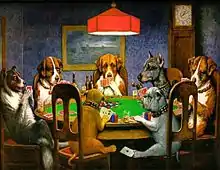Kitsch
Kitsch (/kɪtʃ/ KITCH; loanword from German)[lower-alpha 1][1] is art or other objects that, generally speaking, appeal to popular rather than "high art" tastes. Such objects are sometimes appreciated in a knowingly ironic or humorous way.[2][3][4] The word was first applied to artwork that was a response to certain divisions of 19th-century art with aesthetics that favored what later art critics would consider to be exaggerated sentimentality and melodrama. Hence, "kitsch art" is closely associated with "sentimental art". Kitsch is also related to the concept of camp, because of its humorous and ironic nature.

.jpg.webp)
Kitsch art may often contain palatable, pleasant and romantic themes and visuals that few would find disagreeable, shocking or otherwise objectionable; it generally attempts to appeal to the human condition and its natural standards of beauty on a superficial level. It may also be quaint or "quirky" without being controversial.
To brand visual art as "kitsch" is generally (but not exclusively) pejorative, as it implies that the work in question is gaudy, or that it serves a solely ornamental and decorative purpose rather than amounting to a work of what may be seen as true artistic merit. However, art deemed kitsch may be enjoyed in an entirely positive and sincere manner. The term is also sometimes applied to music or literature, or any work.[5]
History


As a descriptive term, "kitsch" originated in the art markets of Munich in the 1860s and the 1870s, describing cheap, popular, and marketable pictures and sketches.[6] In Das Buch vom Kitsch (The Book of Kitsch), Hans Reimann defines it as a professional expression "born in a painter's studio".
The study of kitsch was done almost exclusively in German until the 1970s, with Walter Benjamin being an important scholar in the field.[7]
Kitsch is regarded as a modern phenomenon, coinciding with social changes in recent centuries such as the Industrial Revolution, urbanization, mass production, modern materials and media such as plastics, radio and television, the rise of the middle class and public education—all of which have factored into a perception of oversaturation of art produced for the popular taste.
Analysis
Kitsch in art theory and aesthetics
Modernist writer Hermann Broch argues that the essence of kitsch is imitation: kitsch mimics its immediate predecessor with no regard to ethics—it aims to copy the beautiful, not the good.[8] According to Walter Benjamin, kitsch is, unlike art, a utilitarian object lacking all critical distance between object and observer; it "offers instantaneous emotional gratification without intellectual effort, without the requirement of distance, without sublimation".[7]
Kitsch is less about the thing observed than about the observer.[9] According to Roger Scruton, "Kitsch is fake art, expressing fake emotions, whose purpose is to deceive the consumer into thinking he feels something deep and serious."[10]
Tomáš Kulka, in Kitsch and Art, starts from two basic facts that kitsch "has an undeniable mass-appeal" and "considered (by the art-educated elite) bad", and then proposes three essential conditions:
Kitsch in Milan Kundera's The Unbearable Lightness of Being
The concept of kitsch is a central motif in Milan Kundera's 1984 novel The Unbearable Lightness of Being. Towards the end of the novel, the book's narrator posits that the act of defecation (and specifically, the shame that surrounds it) poses a metaphysical challenge to the theory of divine creation: "Either/or: either shit is acceptable (in which case don't lock yourself in the bathroom!) or we are created in an unacceptable manner".[14] Thus, in order for us to continue to believe in the essential propriety and rightness of the universe (what the narrator calls "the categorical agreement with being"), we live in a world "in which shit is denied and everyone acts as though it did not exist". For Kundera's narrator, this is the definition of kitsch: an "aesthetic ideal" which "excludes everything from its purview which is essentially unacceptable in human existence".
The novel goes on to relate this definition of kitsch to politics, and specifically — given the novel's setting in Prague around the time of the 1968 invasion by the Soviet Union — to communism and totalitarianism. He gives the example of the Communist May Day ceremony, and of the sight of children running on the grass and the feeling this is supposed to provoke. This emphasis on feeling is fundamental to how kitsch operates:
Kitsch causes two tears to flow in quick succession. The first tear says: How nice to see children running on the grass! The second tear says: How nice to be moved, together with all mankind, by children running on the grass! It is the second tear that makes kitsch kitsch.[15]
According to the narrator, kitsch is "the aesthetic ideal of all politicians and all political parties and movements"; however, where a society is dominated by a single political movement, the result is "totalitarian kitsch":
When I say "totalitarian," what I mean is that everything that infringes on kitsch must be banished for life: every display of individualism (because a deviation from the collective is a spit in the eye of the smiling brotherhood); every doubt (because anyone who starts doubting details will end by doubting life itself); all irony (because in the realm of kitsch everything must be taken quite seriously).[15]
Kundera's concept of "totalitarian kitsch" has since been invoked in the study of the art and culture of regimes such as Stalin's Soviet Union, Nazi Germany, Fascist Italy and Iraq under Saddam Hussein.[16] Kundera's narrator ends up condemning kitsch for its "true function" as an ideological tool under such regimes, calling it "a folding screen set up to curtain off death".[17]
Melancholic kitsch vs. nostalgic kitsch

In her treatise The Artificial Kingdom, cultural historian Celeste Olalquiaga develops a theory of kitsch that situates its emergence as a specifically nineteenth-century phenomenon, relating it to the feelings of loss elicited by a world transformed by science and industry.[18] Focusing on examples such as paperweights, aquariums, mermaids and the Crystal Palace, Olalquiaga uses Benjamin’s concept of the "dialectical image" to argue for the utopian potential of "melancholic kitsch", which she differentiates from the more commonly discussed "nostalgic kitsch".[19]
These two types of kitsch correspond to two different forms of memory. Nostalgic kitsch functions through "reminiscence", which "sacrifices the intensity of experience for a conscious or fabricated sense of continuity":
Incapable of tolerating the intensity of the moment, reminiscence selects and consolidates an event’s acceptable parts into a memory perceived as complete. […] This reconstructed experience is frozen as an emblem of itself, becoming a cultural fossil.[20]
In contrast, melancholic kitsch functions through "remembrance", a form of memory that Olalquiaga links to the "souvenir", which attempts "to repossess the experience of intensity and immediacy through an object".[21] While reminiscence translates a remembered event to the realm of the symbolic ("deprived of immediacy in favour of representational meaning"), remembrance is "the memory of the unconscious", which "sacrific[es] the continuity of time for the intensity of the experience".[22] Far from denying death, melancholic kitsch can only functions through a recognition of its multiple "deaths" as a fragmentary remembrance that is subsequently commodified and reproduced. It "glorifies the perishable aspect of events, seeking in their partial and decaying memory the confirmation of its own temporal dislocation".[23]
Thus, for Olalquiaga, melancholic kitsch is able to function as a Benjaminian dialectical image: "an object whose decayed state exposes and reflects its utopian possibilities, a remnant constantly reliving its own death, a ruin".[21]
Uses
Art
The Kitsch movement is an international movement of classical painters, founded in 1998 upon a philosophy proposed by Odd Nerdrum[24] and later clarified in his book On Kitsch[25] in cooperation with Jan-Ove Tuv and others, incorporating the techniques of the Old Masters with narrative, romanticism, and emotionally charged imagery.
See also
- Camp – Ostentatious style (late 19th century - current)
- Cliché – Idea which has become overused to the point of losing its original meaning or being irritating
- Lowbrow (art movement)
- Museum of Bad Art – Art museum in Massachusetts
- Poshlost – A Russian word for a particular negative human character trait or man-made thing or idea
- Prolefeed – Newspeak term in the novel Nineteen Eighty-Four by George Orwell
- Notable examples
- Velvet Elvis – A painting of Elvis Presley on velvet
- Chinese Girl – 1952 painting by Vladimir Tretchikoff
- Christmas cards
Notes
References
- "Definition of KITSCH". www.merriam-webster.com.
- Company, Houghton Mifflin Harcourt Publishing. "The American Heritage Dictionary entry: kitsch". www.ahdictionary.com.
- "KITSCH | meaning in the Cambridge English Dictionary". dictionary.cambridge.org.
- "Kitsch | Definition of Kitsch by Oxford Dictionary on Lexico.com also meaning of Kitsch". Lexico Dictionaries | English.
- Scruton, Roger (Feb 21, 2014). "A fine line between art and kitsch". Forbes. Retrieved 16 January 2017.
- Calinescu, Matei. Five Faces of Modernity. Kitsch, p. 234.
- Menninghaus, Winfried (2009). "On the Vital Significance of 'Kitsch': Walter Benjamin's Politics of 'Bad Taste'". In Andrew Benjamin (ed.). Walter Benjamin and the Architecture of Modernity. Charles Rice. re.press. pp. 39–58. ISBN 9780980544091.
- Broch, Hermann (2002). "Evil in the Value System of Art". Geist and Zeitgeist: The Spirit in an Unspiritual Age. Six Essays by Hermann Broch. Counterpoint. pp. 13–40. ISBN 9781582431680.
- Eaglestone, Robert (May 25, 2017). The Broken Voice: Reading Post-Holocaust Literature. Oxford University Press. p. 155. ISBN 978-0191084201.
- "A Point of View: The strangely enduring power of kitsch". December 12, 2014 – via www.bbc.com.
- Tomas, Kulka (1996). Kitsch and art. Pennsylvania State Univ. Press. ISBN 978-0271015941. OCLC 837730812.
- Kulka, Tomas (1988-01-01). "KITSCH". The British Journal of Aesthetics. 28 (1): 18–27. doi:10.1093/bjaesthetics/28.1.18. ISSN 0007-0904.
- Higgins, Kathleen Marie (1998-01-01). "Review of Kitsch and Art". The Journal of Aesthetics and Art Criticism. 56 (4): 410–412. doi:10.2307/432137. JSTOR 432137.
- Kundera, Milan (1984). The Unbearable Lightness of Being. Harper Perennial. p. 248
- Kundera, Milan (1984). The Unbearable Lightness of Being. Harper Perennial. p. 251
- Makiya, Kanan (2011). Review: What Is Totalitarian Art? Cultural Kitsch From Stalin to Saddam. Foreign Affairs. 90 (3): 142–148
- Kundera, Milan (1984). The Unbearable Lightness of Being. Harper Perennial. p. 253
- Olalquiaga, Celeste (1999). The Artificial Kingdom: A Treasury of the Kitsch Experience. Bloomsbury.
- Olalquiaga, Celeste (1999). The Artificial Kingdom: A Treasury of the Kitsch Experience. Bloomsbury. pp. 26, 75
- Olalquiaga, Celeste (1999). The Artificial Kingdom: A Treasury of the Kitsch Experience. Bloomsbury. p. 292
- Olalquiaga, Celeste (1999). The Artificial Kingdom: A Treasury of the Kitsch Experience. Bloomsbury. p. 291
- Olalquiaga, Celeste (1999). The Artificial Kingdom: A Treasury of the Kitsch Experience. Bloomsbury. p. 294, 292
- Olalquiaga, Celeste (1999). The Artificial Kingdom: A Treasury of the Kitsch Experience. Bloomsbury. p. 298
- E.J. Pettinger Archived 2012-04-07 at the Wayback Machine "The Kitsch Campaign" [Boise Weekly], December 29, 2004.
- Dag Solhjell and Odd Nerdrum. On Kitsch, Kagge Publishing, August 2001, ISBN 8248901238.
Further reading
- Adorno, Theodor (2001). The Culture Industry. Routledge. ISBN 0-415-25380-2
- Botz-Bornstein, Thorsten (2008). "Wabi and Kitsch: Two Japanese Paradigms" in Æ: Canadian Aesthetics Journal 15.
- Botz-Bornstein, Thorsten (2019) The New Aesthetics of Deculturation: Neoliberalism, Fundamentalism and Kitsch (Bloomsbury). Foreword by Olivier Roy.
- Braungart, Wolfgang (2002). "Kitsch. Faszination und Herausforderung des Banalen und Trivialen". Max Niemeyer Verlag. ISBN 3-484-32112-1/0083-4564.
- Cheetham, Mark A (2001). "Kant, Art and Art History: moments of discipline". Cambridge University Press. ISBN 0-521-80018-8.
- Dorfles, Gillo (1969, translated from the 1968 Italian version, Il Kitsch). Kitsch: The World of Bad Taste, Universe Books. LCCN 78-93950
- Elias, Norbert. (1998[1935]). "The Kitsch Style and the Age of Kitsch," in J. Goudsblom and S. Mennell (eds) The Norbert Elias Reader. Oxford: Blackwell.
- Gelfert, Hans-Dieter (2000). "Was ist Kitsch?". Vandenhoeck & Ruprecht in Göttingen. ISBN 3-525-34024-9.
- Giesz, Ludwig (1971). Phänomenologie des Kitsches. 2. vermehrte und verbesserte Auflage München: Wilhelm Fink Verlag. [Partially translated into English in Dorfles (1969)]. Reprint (1994): Ungekürzte Ausgabe. Frankfurt am Main: S. Fischer Verlag. ISBN 3-596-12034-9 / ISBN 978-3-596-12034-5.
- Gorelik, Boris (2013). Incredible Tretchikoff: Life of an artist and adventurer. Art / Books, London. ISBN 978-1-908970-08-4
- Greenberg, Clement (1978). Art and Culture. Beacon Press. ISBN 0-8070-6681-8
- Holliday, Ruth and Potts, Tracey (2012) Kitsch! Cultural Politics and Taste, Manchester University Press. ISBN 978-0-7190-6616-0
- Karpfen, Fritz (1925). "Kitsch. Eine Studie über die Entartung der Kunst". Weltbund-Verlag, Hamburg.
- Kristeller, Paul Oskar (1990). "The Modern System of the Arts" (In "Renaissance Thought and the Arts"). Princeton University Press. ISBN 978-0-691-02010-5
- Kulka, Tomas (1996). Kitsch and Art. Pennsylvania State University Press. ISBN 0-271-01594-2
- Moles, Abraham (nouvelle édition 1977). Psychologie du Kitsch: L'art du Bonheur, Denoël-Gonthier
- Nerdrum, Odd (Editor) (2001). On Kitsch. Distributed Art Publishers. ISBN 82-489-0123-8
- Olalquiaga, Celeste (2002). The Artificial Kingdom: On the Kitsch Experience. University of Minnesota ISBN 0-8166-4117-X
- Reimann, Hans (1936). "Das Buch vom Kitsch". Piper Verlag, München.
- Richter, Gerd, (1972). Kitsch-Lexicon, Bertelsmann. ISBN 3-570-03148-9
- Ryynänen, Max (2018). "Contemporary Kitsch: The Death of Pseudo Art and the Birth of Everyday Cheesiness (A Postcolonial Inquiry)" in Terra Aestheticae 1, pp. 70–86.
- Scruton, Roger (2009). Beauty: A Very Short Introduction, Oxford University Press ISBN 0199229759
- Scruton, Roger (1983). The Aesthetic Understanding: Essays in the Philosophy of Art and Culture ISBN 1890318027
- Shiner, Larry (2001). "The Invention of Art". University of Chicago Press. ISBN 0-226-75342-5.
- Thuller, Gabrielle (2006 and 2007). "Kunst und Kitsch. Wie erkenne ich?", ISBN 3-7630-2463-8. "Kitsch. Balsam für Herz und Seele", ISBN 978-3-7630-2493-3. (Both on Belser-Verlag, Stuttgart.)
- Ward, Peter (1994). Kitsch in Sync: A Consumer's Guide to Bad Taste, Plexus Publishing. ISBN 0-85965-152-5
- "Kitsch. Texte und Theorien", (2007). Reclam. ISBN 978-3-15-018476-9. (Includes classic texts of kitsch criticism from authors like Theodor Adorno, Ferdinand Avenarius, Edward Koelwel, Walter Benjamin, Ernst Bloch, Hermann Broch, Richard Egenter, etc.).
External links
| Look up kitsch in Wiktionary, the free dictionary. |
| Wikimedia Commons has media related to Kitsch. |
- "Kitsch". In John Walker's Glossary of art, architecture & design since 1945.
- Avant-Garde and Kitsch – essay by Clement Greenberg
- Kitsch and the Modern Predicament – essay by Roger Scruton